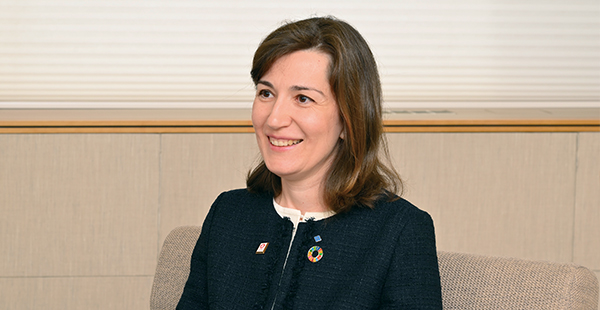Roundtable Talk on Diversity & Inclusion (D&I)
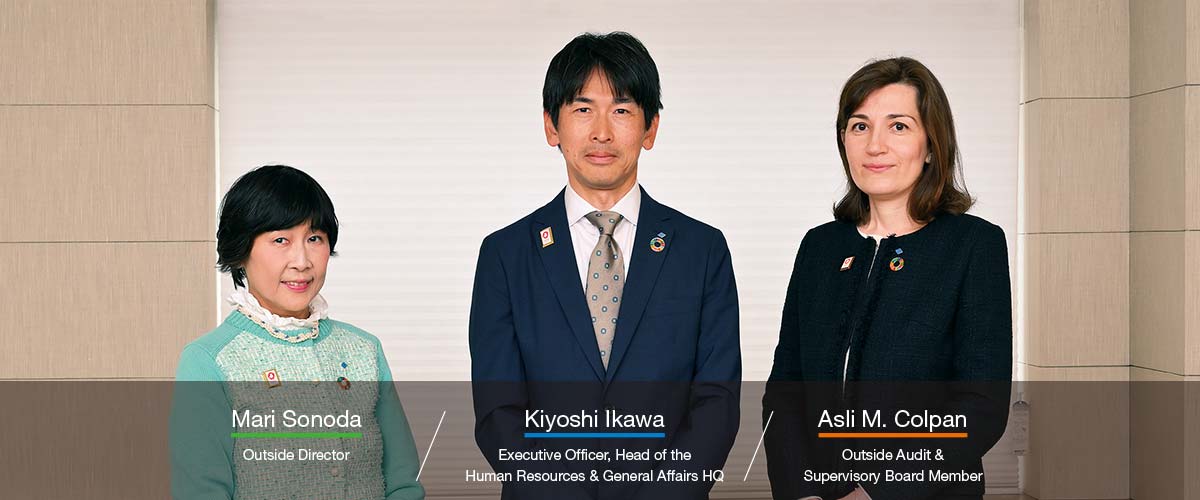
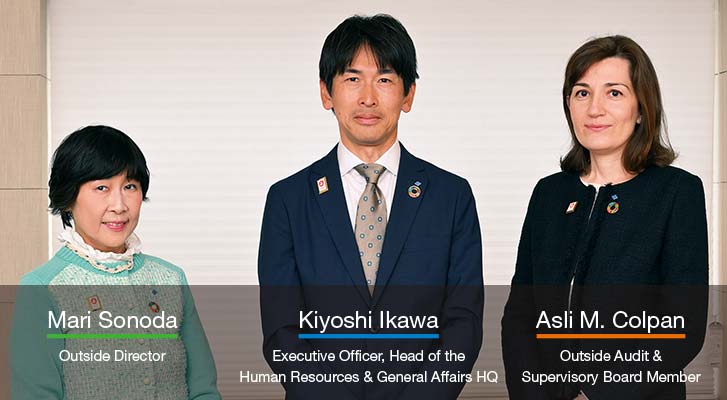
The Sumitomo Rubber Group has positioned “Our Philosophy,” a corporate philosophy structure established in 2020, as a cornerstone for collective endeavors that consolidate the diverse capabilities of its employees and set them on the same vector. Through these endeavors, we aim to embody our Purpose, “Through innovation we will create a future of joy and well-being for all.” Even before establishing this philosophy, we had launched the “Be the Change (BTC)” Project in January 2020 to promote corporate culture reforms.
Here, we present the summary of a roundtable talk in which Kiyoshi Ikawa, an Executive Officer who has spearheaded the BTC Project, Outside Director Mari Sonoda and Outside Audit & Supervisory Board Member Asli M. Colpan together address progress under the corporate culture reforms and ideals regarding what human capital in place at the Sumitomo Rubber Group should look like. (The event was held on March 27, 2023)
Features of Sumitomo Rubber Group Employees and Issues They Face
If there is a defining personality trait among Sumitomo Rubber Group employees, it is sincerity. Also, individuals tasked with technological development and other endeavors display steadfast determination to achieve robust outcomes. I believe that they could be more active in communicating their accomplishments to others. Also, I sometimes feel that if the composition of their teams were a bit more diverse, they could achieve even better results as they take on variety of challenges.
Being diverse means, of course, securing diversity in gender, as well as incorporating foreign nationals. Also, important is diversity among Japanese male employees. This employee group similarly needs to be diverse in terms of ways of thinking and character.
As Ms. Sonoda has pointed out, I, too, consider securing diversity a matter of extreme importance. The Sumitomo Rubber Group now engages in operations on a fairly global scale. Accordingly, I think overseas and domestic employees should work together more often.
From the perspective of an outside officer, it is sometimes hard to see whether foreign national managers operating overseas and the Head Office in Japan are actually engaging in effective collaboration.
With regard to the personal characteristics of employees, most are quite diligent. They meet an extremely high standard in terms of accomplishing the missions assigned to them. On the other hand, there are only a handful who display independent-minded “wandering samurai” traits or demonstrate the capability to judge whether a given task is really necessary and discerning what is truly essential.
Also, many employees seem to believe that they must adhere to precedent and make incremental improvements by building on the present status. Such an approach is what has led to the prevailing culture of working excessive overtime hours.
To rectify this situation, employees should be able to determine priorities and decisively abolish non-essential tasks. We need to take a drastic approach and break away from workstyles premised on overtime. I consider these workstyles to constitute a barrier that must be removed as the Group strives for women’s empowerment in the context of promoting D&I.
In this regard, human skills are key to successful transition. These skills include communication skills enabling frank exchanges of thoughts with peers. The Sumitomo Rubber Group has an urgent need to secure individuals with human skills that transcend the scope of business skills. However, our group has thus far been excessively focused on nurturing “left-brain” type skills. For example, our training programs have largely emphasized problem-solving and logical thinking.
Although the matters I have just touched on are not necessarily relevant to the question, I think that the Sumitomo Rubber Group should clearly announce its priorities when it comes to developing human skills and nurturing individuals who can judge what is truly essential. This, I believe, is the way our group should accelerate efforts to enhance the overall capabilities of its human resources.
In terms of globalization, the Sumitomo Rubber Group has rapidly enhanced its network of bases and expanded the size of its operations over the past several years. Currently, our group is facing a shortage of the kind of human resources who can handle these expanded operations.
Also, the Sumitomo Rubber Group has periodically conducted in-house questionnaires on organizational culture since 2020. Although the Group had conducted quarterly questionnaires at the beginning of the process of reform in order to assess in detail the status of changes in corporate culture, the frequency of these questionnaires has now decreased to twice a year, based on a judgment that this frequency is appropriate in light of the burden placed on respondents who fill out questionnaires. Thus far, we have seen overall improvement in the scores given by employees. On the other hand, we have also identified divisions that are contending with unique issues and entire job grades whose members tend to give lower scores. Based on these and other insights, we need to not only continue implementing improvement measures to address the overall workforce but also incorporate more in-detail measures to address individual employees. We also need to reflect these insights in personnel transfer and otherwise take more specific action to transform our organizational culture.
Outcomes of the BTC Project and Issues to Be Addressed
The “SRI Way,” a component of “Our Philosophy,” clearly defines the three tenets of “Being reliable and worthy of trust,” “Seeking out challenge” and “Valuing one another.” Sumitomo Rubber Group employees are expected to remain conscious of these tenets in the course of daily operations.
Of these, “Being reliable and worthy of trust” is a traditional corporate mindset inherited from the former Sumitomo Group. Therefore, I am not worried about the entrenchment of this tenet. Also, to realize the tenet of “Valuing one another,” we not only implement such basic initiatives as preventing harassment and advocating for respect for human rights but also utilize 360-degree feedback sessions focused on nurturing human skills. In particular, senior managers, ranging from President to Executive Officers, are provided executive coaching to enhance their management capabilities.
On the other hand, how to embody “Seeking out challenge” constitutes the foremost issue. Efforts to foster a culture of seeking out challenges have thus far been unsuccessful. There are two factors behind this situation. First, employees’ sense of psychological safety is less than robust. Many employees are anxious about saying what they really think or afraid of failing in the course of duty. To address this situation, we have held anti-bias seminars to address unconscious biases and otherwise implemented initiatives on multiple occasions to raise employee awareness regarding the need to secure psychological safety in the workplace. In this regard, I feel that these initiatives have begun to yield tangible effects.
However, we are also confronted by another deeply rooted issue arising from employees’ tendency toward maintaining status quo and staying in their comfort zone. Many employees seem to be content with maintaining the status quo because doing so involves no penalty. I think that this situation hinders them from seeking out challenges.
Of course, it is essential to provide employees with a sense of security regarding employment and wages in exchange for their fulfillment of certain performance criteria. However, going forward, the Sumitomo Rubber Group needs to clarify a policy of granting greater rewards to employees who demonstrate strong drives to attain personal growth and contribute to improvement in corporate value. By doing so, our group should genuinely become a workplace of choice for all employees. There must be mutual relationship in which our group chooses and is chosen by employees.
The aforementioned questionnaires also revealed that the issue that frustrates employees most is the vagueness of performance evaluations. Although managers are expected to deliver clear-cut feedback to each staff member regarding their performance, we need to provide managers lacking capabilities to do so with training to help enhance their skills or, if necessary, consider replacing them with other human resources who are robustly equipped for managerial positions.
Needless to say, the commitment of top management is extremely important to enable a company to move forward and achieve transformation. President Yamamoto is currently communicating strong messages to employees and otherwise launching various measures. For the Sumitomo Rubber Group to accomplish reforms, the tireless endeavors of officers and employees are essential. The Group also needs to update performance evaluation and other human resources systems by incorporating specific mechanisms designed to support such endeavors. Moreover, it needs to clearly communicate signals to motivate the entire workforce by, for example, identifying KPIs and setting challenging targets relative to such KPIs.
To supplement matters being discussed by Ms. Sonoda, human capital is now becoming the subject of growing attention among business communities. In step with this, the role of those heading up human resources departments has become extremely important. In order to facilitate the initiatives described above, the Sumitomo Rubber Group needs to develop a variety of human resources systems, for example, a framework for reducing overtime in exchange for requiring higher productivity. At the same time, it needs to pursue flexible workstyles via the use of flextime and other means. If the Group succeeds in these endeavors, it would be able to create an environment that is more friendly to women and other people with diverse attributes.
In addition, I believe that human capital management measures would be more fruitful if the Sumitomo Rubber Group takes a cross-regional approach to the management and allocation of all Group employees, including those operating in countries abroad. In this light, I would like to know about the status of progress in human resources exchanges between domestic and overseas bases.
Let me explain. Roughly speaking, overseas bases consist of production bases and sales subsidiaries.
At overseas production bases, the execution of Head Office policies and plans is initiated by Japanese expatriates. Local employees then implement specific measures in line with said policies and plans. Sales subsidiaries, on the other hand, include both bases overseen by Japanese expatriates and bases run solely by local employees. Therefore, compared with production bases, sales subsidiaries are more likely to confront difficulties in disseminating such important messages as those related to Head Office policies or to be otherwise affected by communication problems. These are issues we need to tackle.
To date, the greater part of our focus has been on developing our organization in Japan rather than development in countries overseas. The rationale contributing to this focus is attributable to results of the first round of questionnaires on organizational culture. Specifically, we have found that domestic employees scored the company much lower, while those at overseas bases gave pretty much high score. While the results gleaned via this round of questionnaires prompted us to launch the BTC Project, we have thus decided to prioritize the improvement of organizational culture in place at domestic bases.
As suggested earlier, we also need to strive further to foster a sense of unity among domestic and overseas bases. Currently, President Yamamoto and I are touring domestic bases to brief employees on the new Midterm Plan and facilitate a robust understanding of said plan among them. Going forward, we will also engage with those at overseas bases via the use of remote meetings to secure similarly robust communications.
Looking at the outcomes of the BTC Project, I personally feel that its greatest success has been in helping senior managers develop a keen awareness of the need to enhance the quality of their execution of duties. Sources of dividends to be paid to shareholders derive from the creation of good products and services. The success of these undertakings hinges on employees. Accordingly, I believe, senior managers’ role is to empower employees to work vibrantly and enable them to achieve high performance. Over past two years, we have been implementing initiatives to enhance the quality of our senior management. As a result, commitment among senior managers to their missions is more solid than ever before. Enhancing the quality of senior management leads to more robust corporate leadership. This, in turn, helps improve the accuracy of overall policies to be executed throughout our group, including management plans.
Entrenchment of D&I among the Workforce
Similarly, strong leadership is important to the entrenchment of D&I, as success ultimately depends on managers’ ability to accommodate the individual circumstances of their staff.
As part of D&I-related initiatives, we have striven to ensure that our Vision of “Uniting our diverse strengths, growing together, driving and thriving on change,” which is a component of “Our Philosophy,” is shared throughout the workforce. This represents the distinctive uniqueness of initiatives undertaken by our group.
These initiatives include a mentoring system in which seasoned employees serve as mentors for younger female employees to assist them in the resolution of issues associated with career development and other concerns to help them achieve personal growth. We are expanding the scope of these and other activities focused on supporting those working on the front lines. I also feel that the pace of initiatives to develop an inclusive environment in which women can work with confidence has been accelerating. For example, operational methods at factory worksites are currently being improved to enable female employees to work comfortably, while female-specific welfare facilities are being developed. These are the most visible changes in this area. I consider our group to have made significant progress as these and other tangible activities continue to steadily move forward.
Topics Mr. Ikawa has just addressed pertain to inclusion in the context of securing a working environment that is friendly to women. In this regard, although simply increasing the representation of women in the workforce is a viable means to promote diversity, it is also important to develop an environment that empowers women to work as successfully as men do.
The Sumitomo Rubber Group has identified a target of raising the ratio of female managers to 7% by 2025. However, I hope to see the Group aim for a higher target.
In addition to raising the ratio of female managers, the Group needs to formulate specific targets regarding the number of female general managers and officers and develop a framework for systematically nurturing female manager candidates so that they can one day become executives. Although the mentoring system is steadily taking root, there is still much to do. I know that President Yamamoto and other top management leaders are quite passionate about promoting D&I, so I also expect them to be strongly focused on achieving tangible results in this area.
In 2023, I launched an executive leader training program at Kyoto University. Looking ahead, I would like to strive even harder for the empowerment of women in Japan.
I personally found that awareness among officers has changed quite a bit over past several years. Going forward, we should then work to create an environment in which employees can feel that “our company has changed.” To this end, each division needs to identify KPIs and otherwise formulate specific measures to ensure that the frameworks and systems developed thus far can be utilized effectively.
There are numerous rationales for promoting D&I. Among these, the need to counter labor shortages is becoming the major pressing issue of this era. If we fail to take a forward-looking approach to promoting D&I, the Group could one day be confronted by the depletion of human resources. In sum, the future viability of the Sumitomo Rubber Group depends of the success of D&I.
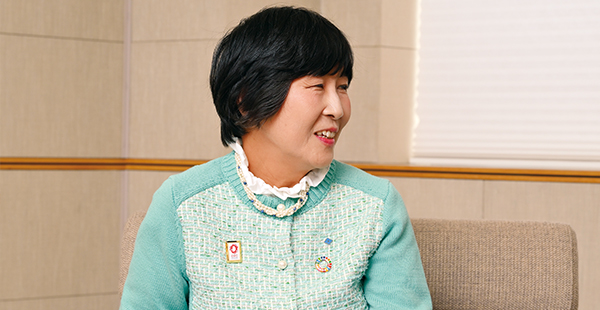
I have seen a number of instances in which women are inhibited by a “glass ceiling,” an invisible barrier blocking them from pursuing career advancement. The presence of such a “glass ceiling” is the most profound issue that must be addressed to promote D&I. Having also discussed this problem with male businesspeople in a diverse range of corporations, I have been quite surprised by their responses as the majority of them simply consider this problem to be women’s issue. However, when I engage with female businesspeople, most of them share their frustration about a typical situation in which they are not allowed to pursue career advancement despite their willingness to do so. This suggests, I believe, that the absence of viable career options available to women inhibits them from pursuing career advancement. It’s not a result of women’s choice of career options.
As a mother of a child, I, too, have experienced diverse challenges in the course of my career. I can conclude that female workers will be better motivated if a company provides them with an inclusive environment and systems that allow them to continue to work with confidence even as they take on various life events and child rearing. Certain research has revealed that changes in male employees’ ways of thinking and the resulting shift in workplace atmosphere and systems will lead to higher representation of female executives and, ultimately, contribute to corporate innovation and better corporate performance. Accordingly, I expect the Sumitomo Rubber Group to promote D&I by setting its sights on achieving outcomes like these over the medium to long term.
Our group’s target of raising the ratio of female managers to 7% is somewhat higher than similar targets set by competitors. However, I, too, would like to see our group to set its sights higher.
Beneficiaries of workstyle reforms are not limited to women. As mentioned by Mr. Ikawa, these reforms should aim for the creation of a working environment that is friendly to all employees since both fathers and mothers have roles to play in child rearing. Furthermore, it is very important to provide an environment supportive of individuals who suffer from medical conditions or those requiring special consideration due to their post-recovery health conditions irrespective of their gender. In addition, there could be employees who face restrictions regarding working hours due to their provision of nursing care to parents or partners. We need to be highly considerate of such individuals, who are often reticent regarding their difficult circumstances.
I believe that encouraging male employees to take childcare leave will serve as a great catalyst in the promotion of D&I. Once male employees gain actual experience in child rearing, they become keenly aware of how hard it can be. This will, I believe, help them update their perception of their female colleagues and prompt male managers to shift their styles of team management. A paternity leave system is already in place at the Sumitomo Rubber Group, so it is important to cultivate a culture in which taking paternity leave is commonplace among male employees.
Workstyle reforms can not be accomplished without abolishing non-essential operations. These reforms should go in tandem with operational streamlining and rationalization. I believe that the success of these reforms will naturally result in higher productivity which, in turn, will enable the Sumitomo Rubber Group to achieve more robust financial results.
As stated by Ms. Colpan, D&I-related initiatives are pointless unless we seriously aim for the creation of workforce in which women’s presence is commonplace in every job grade, including senior management.
Looking at the age-based composition of employees, women aged 35 or younger account for a significant proportion in our overall female workers. Therefore, we must first develop a framework to improve the retention of these female workers and empower them to gain diverse experiences so that they acquire robust capabilities. They are also in immediate need of role models. Accordingly, I would like to be part of realizing the first female executive at our group in the near future. The appointment of a female executive will be symbolic to other female workers and help convince them about their potential to assume similar leading positions. I would like them to be confident that women can pursue careers at the Sumitomo Rubber Group just as men are usually doing. Moreover, such an appointment will send a profound message of encouragement to not only female workers but also young male workers and job-seeking students.
The Sumitomo Rubber Group’s Succession Plan
To nurture next-generation management human resources, we have already launched a talent management framework. This framework systematically nurtures candidates for future senior managers who will oversee specific functions, for example, the Human Resources & General Affairs HQ. In short, to identify skill sets for each department with specific functions we strive to make the status of human resources visible in line with the two axes of human skills and problem-identification and solving capabilities. In this way, we aim to discover optimal candidates while formulating training menus targeting areas in which our human resources need to enhance their competencies.
In August 2022, we launched a similar framework for nurturing top management leader candidates. With target candidates being selected from among the heads of each department with specific functions or those in similar positions, this framework not only provides them with lectures and other training programs but also allows them to gain diverse experience and assigns them challenging missions. Our talent management approach is focused on identifying candidates from among both management and specialist human resources. For specialist human resources, we endeavor to enable the systematic acquisition of experience in differing fields in line with our aim of discovering outstanding candidates. This will help us secure individuals equipped with strengths in multiple areas of specialty, which, in turn, empowers them to leverage a broader perspective independent of conventional wisdom in one specific field.
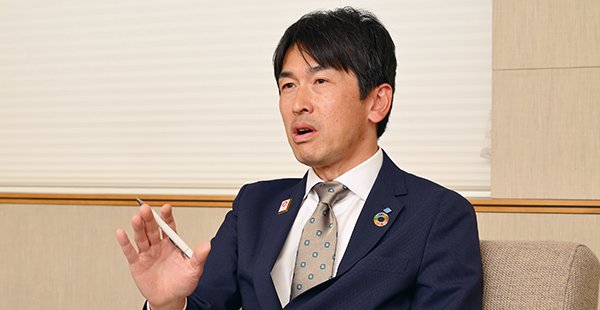
Senior managers who oversee specific functions (e.g., the head of Production HQ, Executive Officer in charge of Technology and general managers or Executive Officers in charge of finance) are equipped with outstanding expertise in their fields of specialty. However, once appointed as Directors, they will be asked to supervise the operations of the entire Group and thus need to understand governance, finance and other matters. Therefore, we need to nurture human resources capable of handling a certain amount of overall business management.
This means we need to secure Directors whose skill matrices indicate their strengths in multiple fields, doesn’t it?
Exactly. Instead of appointing Directors with single area of strength, we need to secure internal directors whose areas of strength encompass the majority of items listed in the skill matrix. I believe that, otherwise, the Board of Directors could fail to be fully functional.
The other day, the Governance Team of the General Affairs Department completed the list of requirements for Director candidates. We are now gearing up our efforts to operate a full-fledged framework for nurturing top management leaders by targeting those in their 40s or late 30s as candidates.
The business environment will continue to change radically going forward. Accordingly, it is imperative to identify candidates from among individuals now in their 30s or 40s, a pool of several hundred employees, as we aim to nurture future leaders capable of navigating our group through the prevailing circumstances of the time. In this light, I think that enabling candidates to gain diverse experience is essential to securing individuals who can leverage a broad perspective and exercise flexible judgments.
Some leadership requirements are universally applicable irrespective of the changing times. Also, there are certain individuals who are naturally endowed with leadership qualities and those who are not. On the other hand, leadership requirements can evolve over time. We need to comprehensively consider such questions. I believe that it will be beneficial to develop a diverse range of succession plans incorporating the types of experience our candidates are expected to gain and knowledge that should be passed down to future generations of leaders upon the clarification of the talent development measures that can be initiated immediately.
When it comes to succession planning, we have incorporated a scientific approach, for example, narrowing down candidates via character analysis that employs a database regarding traits of successful corporate managers around the world.
Currently, 32,000 out of our 40,000 Group employees, including those working at affiliates, are foreign nationals. From the perspective of how to navigate the Sumitomo Rubber Group’s global operations, individuals equipped with global experience and capable of demonstrating strength in international operations are optimal to our group’s management successors.
Leadership Traits Are Unchanging Regardless of the Times
Looking at the time frame leading up to 2050, I believe that some leadership traits are universally applicable and will remain relevant in the future. These timeless traits are problem-identification capabilities, problem-solving capabilities and the ability to persuade and lead others. As for the relationships between these three traits and top management leaders, managers and frontline employees, problem identification is the skill most required of top management leaders. On the other hand, concept building capabilities for problem-solving are what managers most need when introducing the use of DX or other measures. Frontline employees are expected to stably implement such measures to resolve problems. Also, human skills are of importance for employees in all ranks. With regard to these skills, individuals in manager positions or higher must be capable of better motivating their staff. The human communication skills required of frontline employees include the ability to empower and collaborate with others.
It is expected that by 2050, unprecedented changes will have taken place at a breathtaking speed. With the widespread use of AI, menial labor will be taken over by AI. Thus, the focus for human workers will be more on decision making and navigating the future direction of business. Accordingly, human resources with flexible and agile judgment capabilities will be sought after.
Therefore, in the coming era, the genuine value of top management leaders will be dependent on their organizational management and human resource development skills.
Nurturing human resources requires a balance between providing them with input and entrusting them with certain tasks. Providing input refers to giving general direction or suggestions based on the assessment of their skills and expertise. Leaders should then entrust them with specific tasks and let them think for themselves. As the environment can change radically over time, leaders’ experience of success might not be applicable to all problems. Therefore, leaders should turn to their staff and ask, “This task went like this in my experience, but what do you think?” and entrust them with carrying out the task. A balance between input and entrustment is, I believe, a timeless trait of good leaders.
In reality, all leaders have their areas of strength and weakness. Therefore, empowering each individual to fully realize their competencies should be at the core of human resource management backed by diversity. In other words, diversity management must aim to empower each employee to thrive.
I would like Sumitomo Rubber Group to become, in 2050, a company with an atmosphere that allows any employee equipped with skills and leadership to come forward as a candidate for President regardless of their gender or nationality. Although we still have sufficient time until 2050, we must begin to develop a framework to that end at this point in time.
